Business Environment Analysis: A Study of NESTLE's Operations
VerifiedAdded on 2020/01/07
|15
|4989
|487
Report
AI Summary
This report provides a comprehensive analysis of NESTLE's business environment. It begins with an introduction to the importance of the business environment and its impact on organizational operations, including internal and external factors and the role of stakeholders. The report then delves into NESTLE's operations, examining its organizational structure, including private, public, and voluntary organizations, and its approach to stakeholder management, emphasizing corporate social responsibility and sustainability. The study further explores economic systems like market, command, and mixed economies, highlighting the influence of fiscal and monetary policies, as well as public sector borrowings. Finally, it investigates competition policies and their impact on NESTLE's business activities, covering acts like the Competition Act 1998 and the Enterprise Act 2002. The report concludes by summarizing the key findings and implications of the analysis.
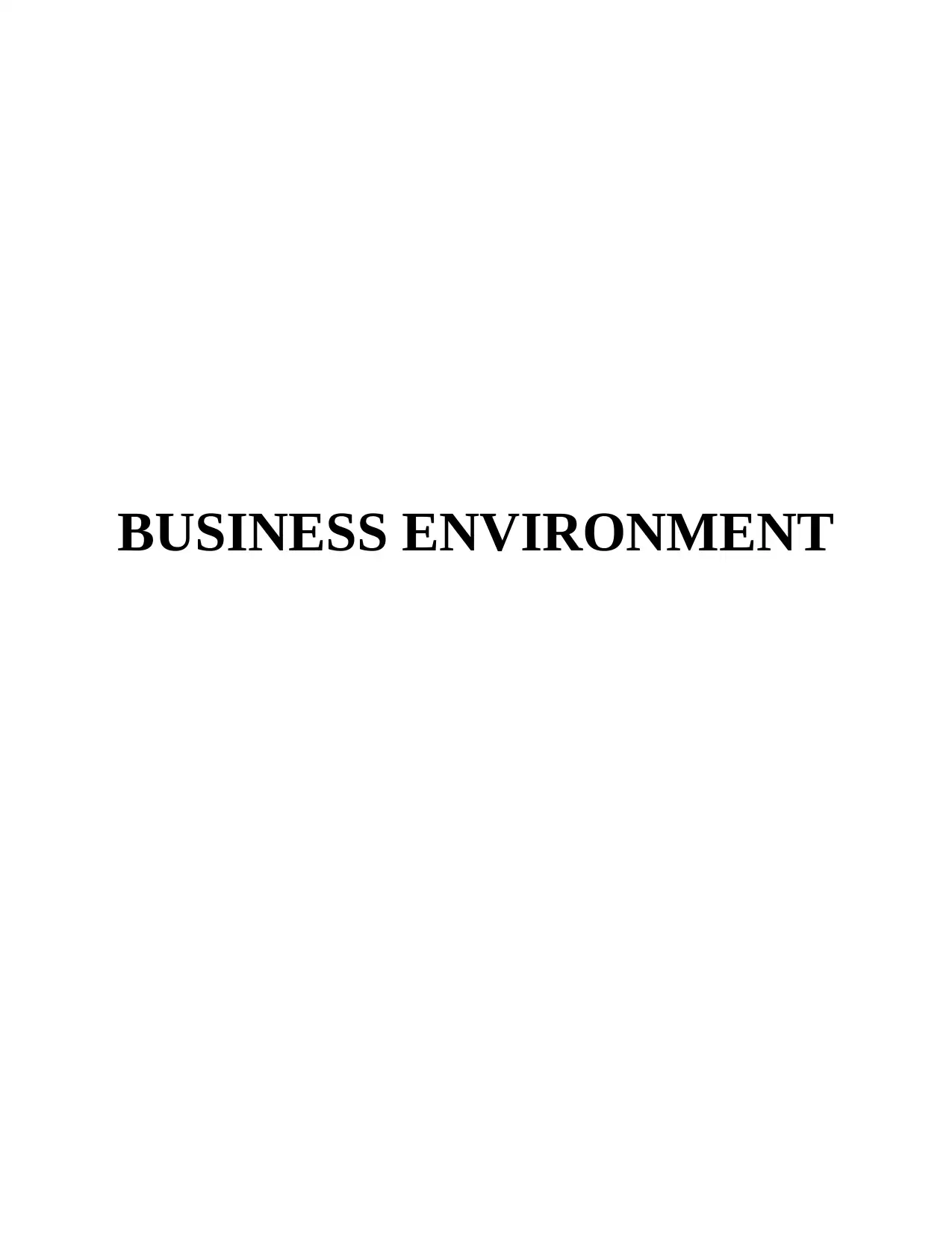
BUSINESS ENVIRONMENT
Paraphrase This Document
Need a fresh take? Get an instant paraphrase of this document with our AI Paraphraser
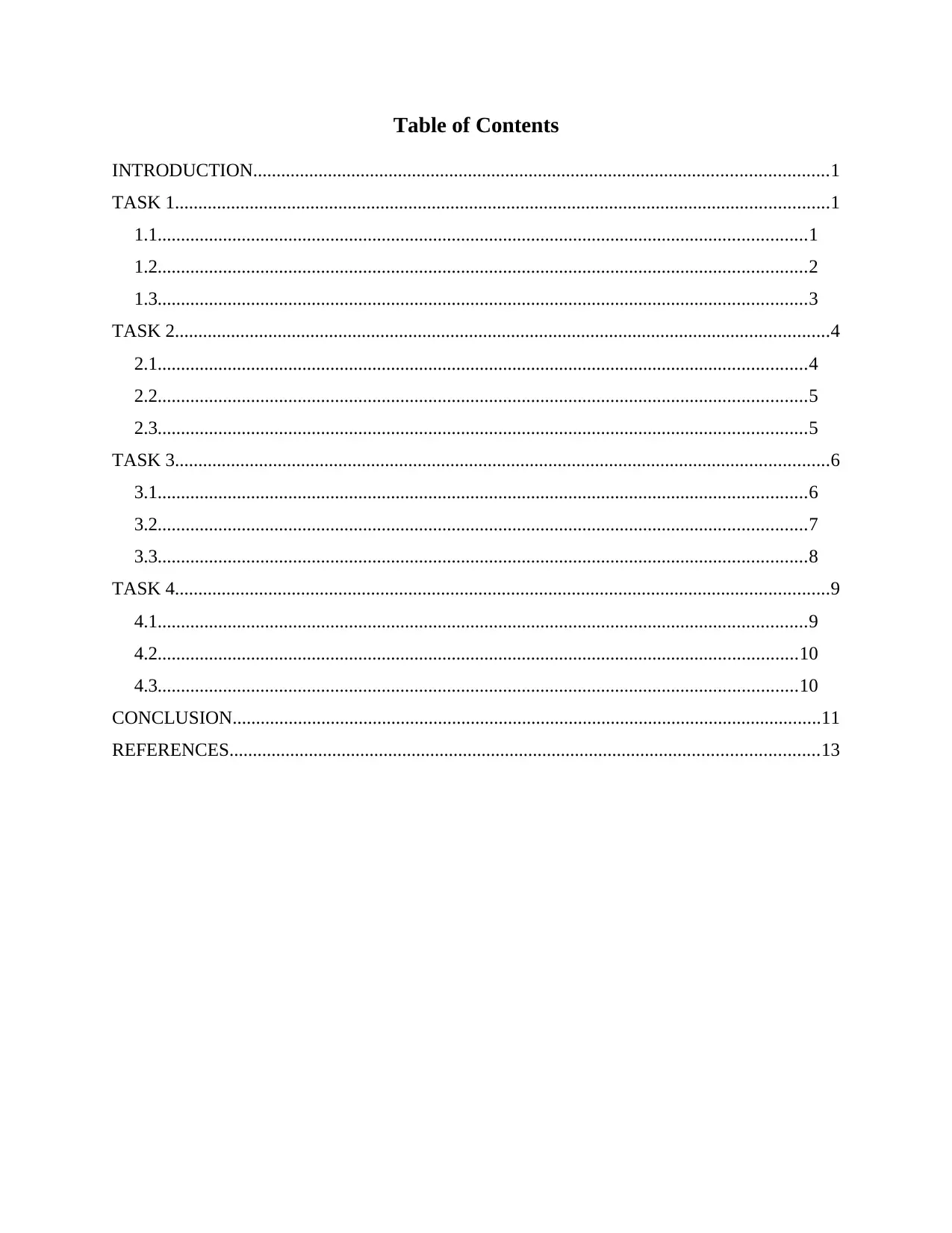
Table of Contents
INTRODUCTION...........................................................................................................................1
TASK 1............................................................................................................................................1
1.1...........................................................................................................................................1
1.2...........................................................................................................................................2
1.3...........................................................................................................................................3
TASK 2............................................................................................................................................4
2.1...........................................................................................................................................4
2.2...........................................................................................................................................5
2.3...........................................................................................................................................5
TASK 3............................................................................................................................................6
3.1...........................................................................................................................................6
3.2...........................................................................................................................................7
3.3...........................................................................................................................................8
TASK 4............................................................................................................................................9
4.1...........................................................................................................................................9
4.2.........................................................................................................................................10
4.3.........................................................................................................................................10
CONCLUSION..............................................................................................................................11
REFERENCES..............................................................................................................................13
INTRODUCTION...........................................................................................................................1
TASK 1............................................................................................................................................1
1.1...........................................................................................................................................1
1.2...........................................................................................................................................2
1.3...........................................................................................................................................3
TASK 2............................................................................................................................................4
2.1...........................................................................................................................................4
2.2...........................................................................................................................................5
2.3...........................................................................................................................................5
TASK 3............................................................................................................................................6
3.1...........................................................................................................................................6
3.2...........................................................................................................................................7
3.3...........................................................................................................................................8
TASK 4............................................................................................................................................9
4.1...........................................................................................................................................9
4.2.........................................................................................................................................10
4.3.........................................................................................................................................10
CONCLUSION..............................................................................................................................11
REFERENCES..............................................................................................................................13
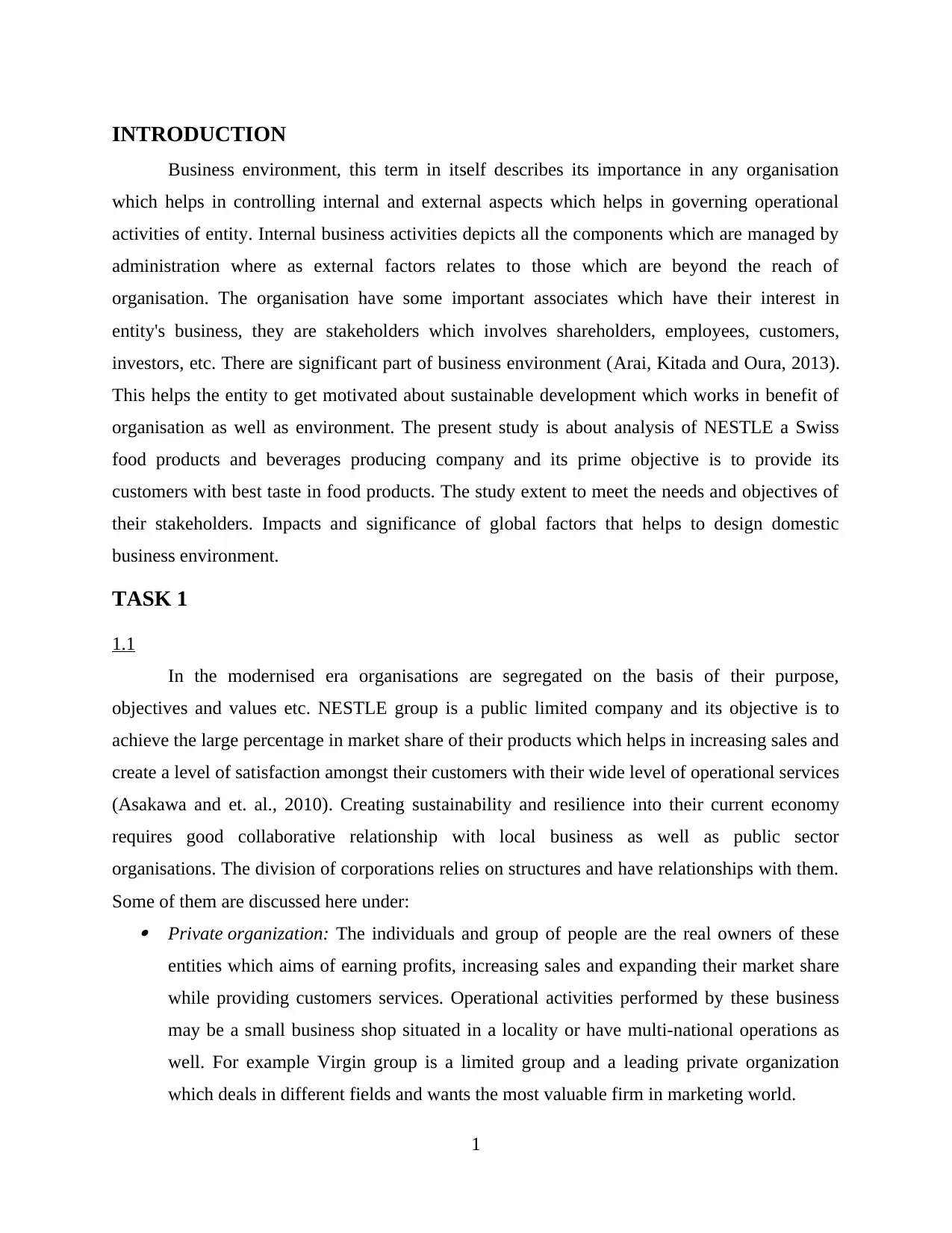
INTRODUCTION
Business environment, this term in itself describes its importance in any organisation
which helps in controlling internal and external aspects which helps in governing operational
activities of entity. Internal business activities depicts all the components which are managed by
administration where as external factors relates to those which are beyond the reach of
organisation. The organisation have some important associates which have their interest in
entity's business, they are stakeholders which involves shareholders, employees, customers,
investors, etc. There are significant part of business environment (Arai, Kitada and Oura, 2013).
This helps the entity to get motivated about sustainable development which works in benefit of
organisation as well as environment. The present study is about analysis of NESTLE a Swiss
food products and beverages producing company and its prime objective is to provide its
customers with best taste in food products. The study extent to meet the needs and objectives of
their stakeholders. Impacts and significance of global factors that helps to design domestic
business environment.
TASK 1
1.1
In the modernised era organisations are segregated on the basis of their purpose,
objectives and values etc. NESTLE group is a public limited company and its objective is to
achieve the large percentage in market share of their products which helps in increasing sales and
create a level of satisfaction amongst their customers with their wide level of operational services
(Asakawa and et. al., 2010). Creating sustainability and resilience into their current economy
requires good collaborative relationship with local business as well as public sector
organisations. The division of corporations relies on structures and have relationships with them.
Some of them are discussed here under: Private organization: The individuals and group of people are the real owners of these
entities which aims of earning profits, increasing sales and expanding their market share
while providing customers services. Operational activities performed by these business
may be a small business shop situated in a locality or have multi-national operations as
well. For example Virgin group is a limited group and a leading private organization
which deals in different fields and wants the most valuable firm in marketing world.
1
Business environment, this term in itself describes its importance in any organisation
which helps in controlling internal and external aspects which helps in governing operational
activities of entity. Internal business activities depicts all the components which are managed by
administration where as external factors relates to those which are beyond the reach of
organisation. The organisation have some important associates which have their interest in
entity's business, they are stakeholders which involves shareholders, employees, customers,
investors, etc. There are significant part of business environment (Arai, Kitada and Oura, 2013).
This helps the entity to get motivated about sustainable development which works in benefit of
organisation as well as environment. The present study is about analysis of NESTLE a Swiss
food products and beverages producing company and its prime objective is to provide its
customers with best taste in food products. The study extent to meet the needs and objectives of
their stakeholders. Impacts and significance of global factors that helps to design domestic
business environment.
TASK 1
1.1
In the modernised era organisations are segregated on the basis of their purpose,
objectives and values etc. NESTLE group is a public limited company and its objective is to
achieve the large percentage in market share of their products which helps in increasing sales and
create a level of satisfaction amongst their customers with their wide level of operational services
(Asakawa and et. al., 2010). Creating sustainability and resilience into their current economy
requires good collaborative relationship with local business as well as public sector
organisations. The division of corporations relies on structures and have relationships with them.
Some of them are discussed here under: Private organization: The individuals and group of people are the real owners of these
entities which aims of earning profits, increasing sales and expanding their market share
while providing customers services. Operational activities performed by these business
may be a small business shop situated in a locality or have multi-national operations as
well. For example Virgin group is a limited group and a leading private organization
which deals in different fields and wants the most valuable firm in marketing world.
1
⊘ This is a preview!⊘
Do you want full access?
Subscribe today to unlock all pages.

Trusted by 1+ million students worldwide
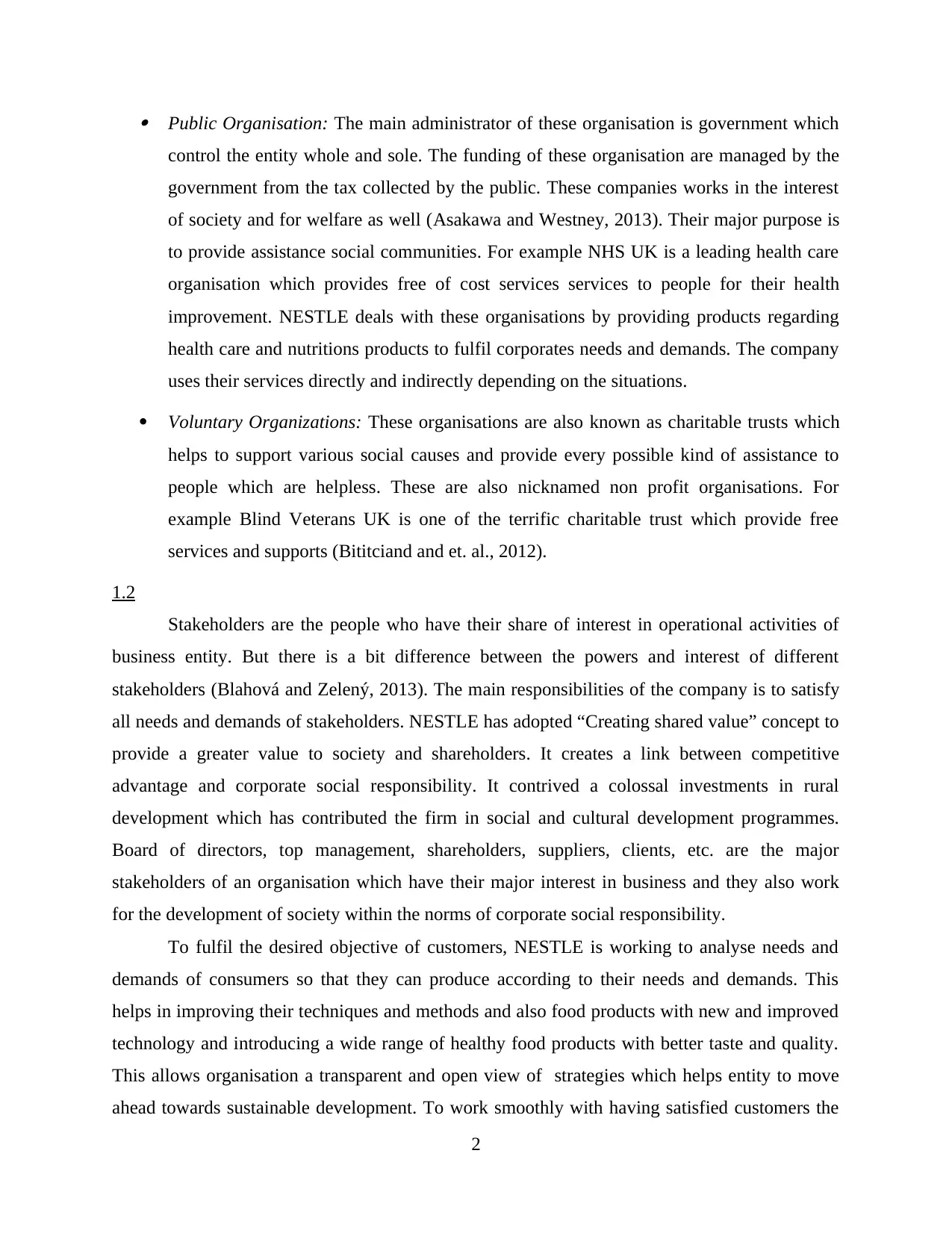
Public Organisation: The main administrator of these organisation is government which
control the entity whole and sole. The funding of these organisation are managed by the
government from the tax collected by the public. These companies works in the interest
of society and for welfare as well (Asakawa and Westney, 2013). Their major purpose is
to provide assistance social communities. For example NHS UK is a leading health care
organisation which provides free of cost services services to people for their health
improvement. NESTLE deals with these organisations by providing products regarding
health care and nutritions products to fulfil corporates needs and demands. The company
uses their services directly and indirectly depending on the situations.
Voluntary Organizations: These organisations are also known as charitable trusts which
helps to support various social causes and provide every possible kind of assistance to
people which are helpless. These are also nicknamed non profit organisations. For
example Blind Veterans UK is one of the terrific charitable trust which provide free
services and supports (Bititciand and et. al., 2012).
1.2
Stakeholders are the people who have their share of interest in operational activities of
business entity. But there is a bit difference between the powers and interest of different
stakeholders (Blahová and Zelený, 2013). The main responsibilities of the company is to satisfy
all needs and demands of stakeholders. NESTLE has adopted “Creating shared value” concept to
provide a greater value to society and shareholders. It creates a link between competitive
advantage and corporate social responsibility. It contrived a colossal investments in rural
development which has contributed the firm in social and cultural development programmes.
Board of directors, top management, shareholders, suppliers, clients, etc. are the major
stakeholders of an organisation which have their major interest in business and they also work
for the development of society within the norms of corporate social responsibility.
To fulfil the desired objective of customers, NESTLE is working to analyse needs and
demands of consumers so that they can produce according to their needs and demands. This
helps in improving their techniques and methods and also food products with new and improved
technology and introducing a wide range of healthy food products with better taste and quality.
This allows organisation a transparent and open view of strategies which helps entity to move
ahead towards sustainable development. To work smoothly with having satisfied customers the
2
control the entity whole and sole. The funding of these organisation are managed by the
government from the tax collected by the public. These companies works in the interest
of society and for welfare as well (Asakawa and Westney, 2013). Their major purpose is
to provide assistance social communities. For example NHS UK is a leading health care
organisation which provides free of cost services services to people for their health
improvement. NESTLE deals with these organisations by providing products regarding
health care and nutritions products to fulfil corporates needs and demands. The company
uses their services directly and indirectly depending on the situations.
Voluntary Organizations: These organisations are also known as charitable trusts which
helps to support various social causes and provide every possible kind of assistance to
people which are helpless. These are also nicknamed non profit organisations. For
example Blind Veterans UK is one of the terrific charitable trust which provide free
services and supports (Bititciand and et. al., 2012).
1.2
Stakeholders are the people who have their share of interest in operational activities of
business entity. But there is a bit difference between the powers and interest of different
stakeholders (Blahová and Zelený, 2013). The main responsibilities of the company is to satisfy
all needs and demands of stakeholders. NESTLE has adopted “Creating shared value” concept to
provide a greater value to society and shareholders. It creates a link between competitive
advantage and corporate social responsibility. It contrived a colossal investments in rural
development which has contributed the firm in social and cultural development programmes.
Board of directors, top management, shareholders, suppliers, clients, etc. are the major
stakeholders of an organisation which have their major interest in business and they also work
for the development of society within the norms of corporate social responsibility.
To fulfil the desired objective of customers, NESTLE is working to analyse needs and
demands of consumers so that they can produce according to their needs and demands. This
helps in improving their techniques and methods and also food products with new and improved
technology and introducing a wide range of healthy food products with better taste and quality.
This allows organisation a transparent and open view of strategies which helps entity to move
ahead towards sustainable development. To work smoothly with having satisfied customers the
2
Paraphrase This Document
Need a fresh take? Get an instant paraphrase of this document with our AI Paraphraser
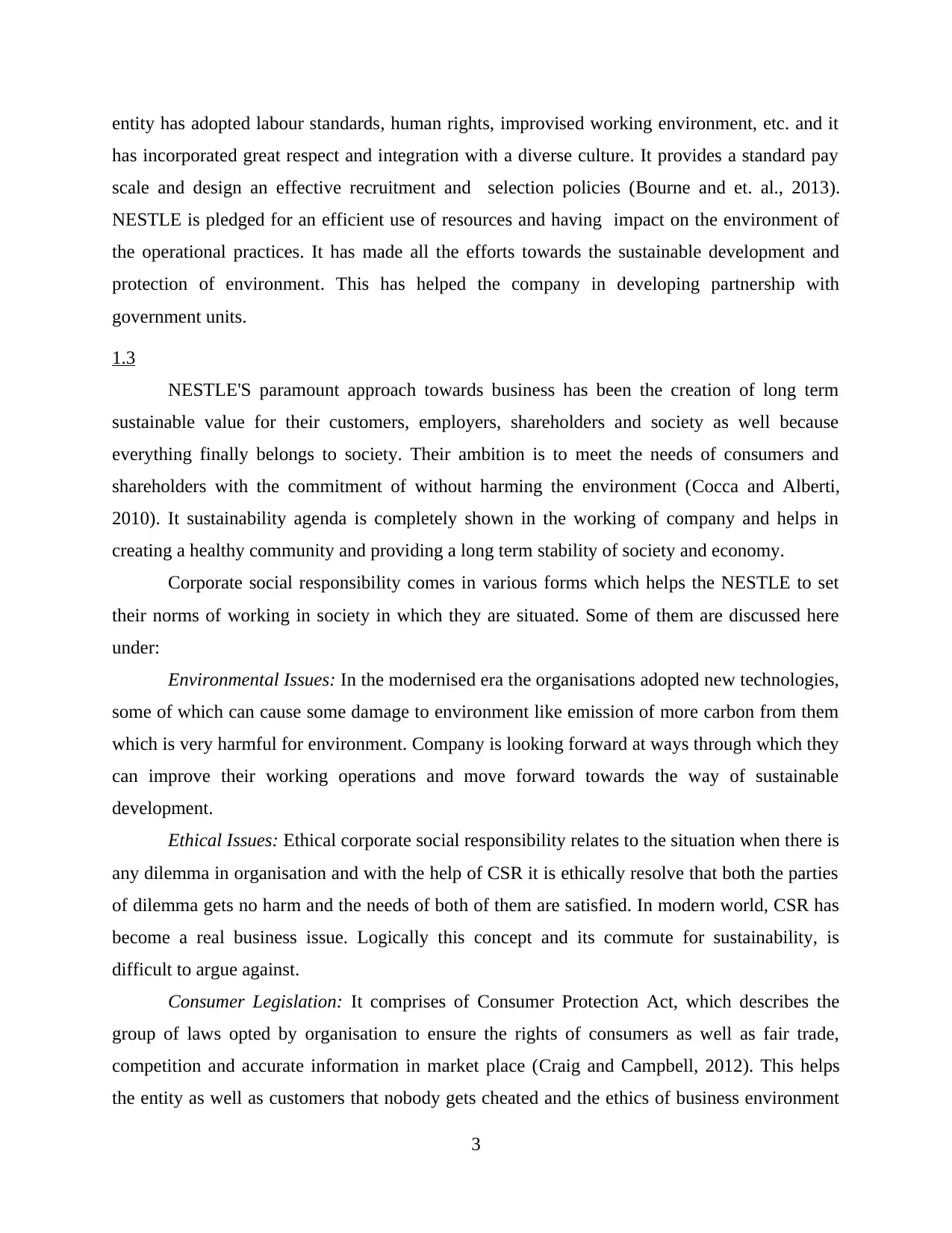
entity has adopted labour standards, human rights, improvised working environment, etc. and it
has incorporated great respect and integration with a diverse culture. It provides a standard pay
scale and design an effective recruitment and selection policies (Bourne and et. al., 2013).
NESTLE is pledged for an efficient use of resources and having impact on the environment of
the operational practices. It has made all the efforts towards the sustainable development and
protection of environment. This has helped the company in developing partnership with
government units.
1.3
NESTLE'S paramount approach towards business has been the creation of long term
sustainable value for their customers, employers, shareholders and society as well because
everything finally belongs to society. Their ambition is to meet the needs of consumers and
shareholders with the commitment of without harming the environment (Cocca and Alberti,
2010). It sustainability agenda is completely shown in the working of company and helps in
creating a healthy community and providing a long term stability of society and economy.
Corporate social responsibility comes in various forms which helps the NESTLE to set
their norms of working in society in which they are situated. Some of them are discussed here
under:
Environmental Issues: In the modernised era the organisations adopted new technologies,
some of which can cause some damage to environment like emission of more carbon from them
which is very harmful for environment. Company is looking forward at ways through which they
can improve their working operations and move forward towards the way of sustainable
development.
Ethical Issues: Ethical corporate social responsibility relates to the situation when there is
any dilemma in organisation and with the help of CSR it is ethically resolve that both the parties
of dilemma gets no harm and the needs of both of them are satisfied. In modern world, CSR has
become a real business issue. Logically this concept and its commute for sustainability, is
difficult to argue against.
Consumer Legislation: It comprises of Consumer Protection Act, which describes the
group of laws opted by organisation to ensure the rights of consumers as well as fair trade,
competition and accurate information in market place (Craig and Campbell, 2012). This helps
the entity as well as customers that nobody gets cheated and the ethics of business environment
3
has incorporated great respect and integration with a diverse culture. It provides a standard pay
scale and design an effective recruitment and selection policies (Bourne and et. al., 2013).
NESTLE is pledged for an efficient use of resources and having impact on the environment of
the operational practices. It has made all the efforts towards the sustainable development and
protection of environment. This has helped the company in developing partnership with
government units.
1.3
NESTLE'S paramount approach towards business has been the creation of long term
sustainable value for their customers, employers, shareholders and society as well because
everything finally belongs to society. Their ambition is to meet the needs of consumers and
shareholders with the commitment of without harming the environment (Cocca and Alberti,
2010). It sustainability agenda is completely shown in the working of company and helps in
creating a healthy community and providing a long term stability of society and economy.
Corporate social responsibility comes in various forms which helps the NESTLE to set
their norms of working in society in which they are situated. Some of them are discussed here
under:
Environmental Issues: In the modernised era the organisations adopted new technologies,
some of which can cause some damage to environment like emission of more carbon from them
which is very harmful for environment. Company is looking forward at ways through which they
can improve their working operations and move forward towards the way of sustainable
development.
Ethical Issues: Ethical corporate social responsibility relates to the situation when there is
any dilemma in organisation and with the help of CSR it is ethically resolve that both the parties
of dilemma gets no harm and the needs of both of them are satisfied. In modern world, CSR has
become a real business issue. Logically this concept and its commute for sustainability, is
difficult to argue against.
Consumer Legislation: It comprises of Consumer Protection Act, which describes the
group of laws opted by organisation to ensure the rights of consumers as well as fair trade,
competition and accurate information in market place (Craig and Campbell, 2012). This helps
the entity as well as customers that nobody gets cheated and the ethics of business environment
3
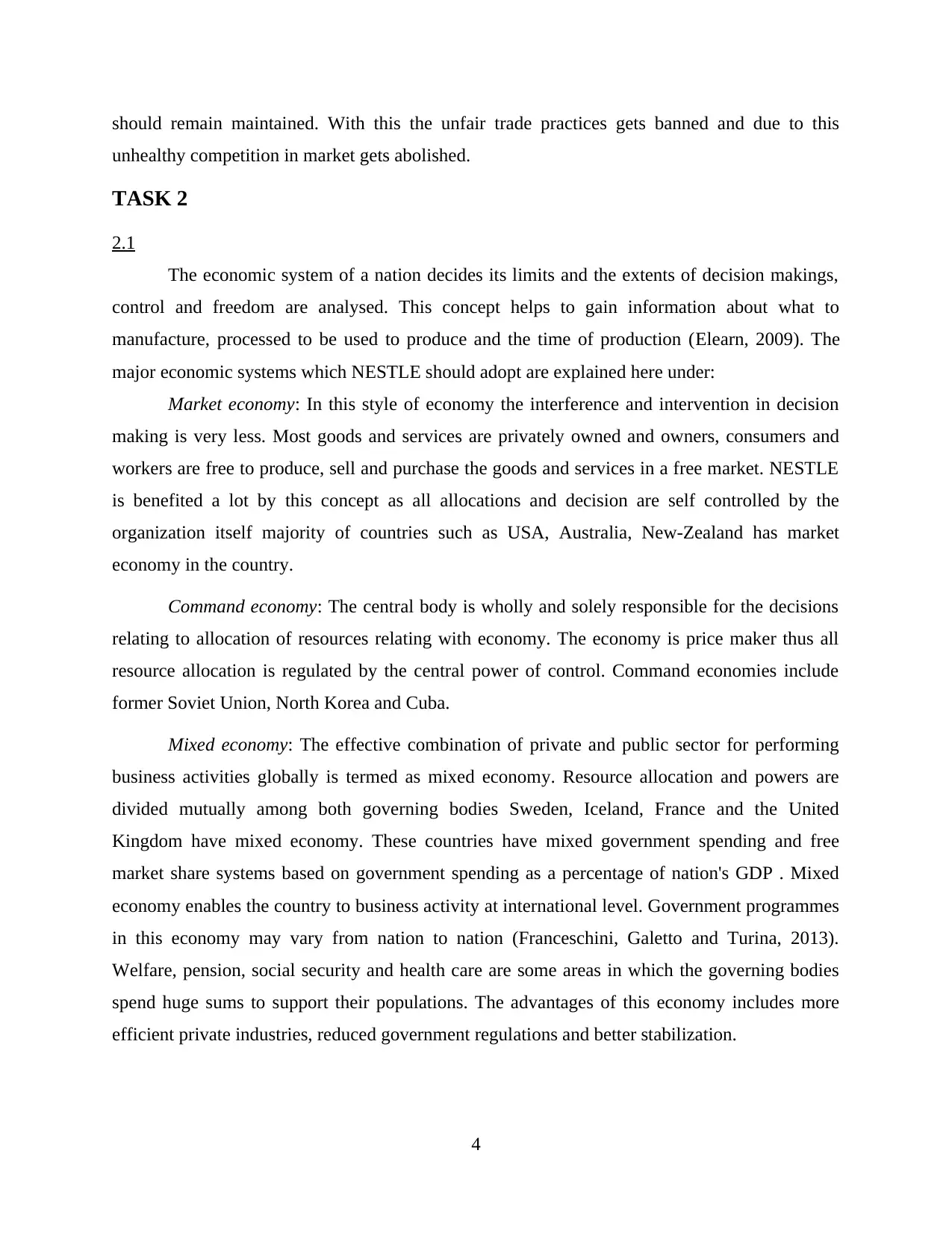
should remain maintained. With this the unfair trade practices gets banned and due to this
unhealthy competition in market gets abolished.
TASK 2
2.1
The economic system of a nation decides its limits and the extents of decision makings,
control and freedom are analysed. This concept helps to gain information about what to
manufacture, processed to be used to produce and the time of production (Elearn, 2009). The
major economic systems which NESTLE should adopt are explained here under:
Market economy: In this style of economy the interference and intervention in decision
making is very less. Most goods and services are privately owned and owners, consumers and
workers are free to produce, sell and purchase the goods and services in a free market. NESTLE
is benefited a lot by this concept as all allocations and decision are self controlled by the
organization itself majority of countries such as USA, Australia, New-Zealand has market
economy in the country.
Command economy: The central body is wholly and solely responsible for the decisions
relating to allocation of resources relating with economy. The economy is price maker thus all
resource allocation is regulated by the central power of control. Command economies include
former Soviet Union, North Korea and Cuba.
Mixed economy: The effective combination of private and public sector for performing
business activities globally is termed as mixed economy. Resource allocation and powers are
divided mutually among both governing bodies Sweden, Iceland, France and the United
Kingdom have mixed economy. These countries have mixed government spending and free
market share systems based on government spending as a percentage of nation's GDP . Mixed
economy enables the country to business activity at international level. Government programmes
in this economy may vary from nation to nation (Franceschini, Galetto and Turina, 2013).
Welfare, pension, social security and health care are some areas in which the governing bodies
spend huge sums to support their populations. The advantages of this economy includes more
efficient private industries, reduced government regulations and better stabilization.
4
unhealthy competition in market gets abolished.
TASK 2
2.1
The economic system of a nation decides its limits and the extents of decision makings,
control and freedom are analysed. This concept helps to gain information about what to
manufacture, processed to be used to produce and the time of production (Elearn, 2009). The
major economic systems which NESTLE should adopt are explained here under:
Market economy: In this style of economy the interference and intervention in decision
making is very less. Most goods and services are privately owned and owners, consumers and
workers are free to produce, sell and purchase the goods and services in a free market. NESTLE
is benefited a lot by this concept as all allocations and decision are self controlled by the
organization itself majority of countries such as USA, Australia, New-Zealand has market
economy in the country.
Command economy: The central body is wholly and solely responsible for the decisions
relating to allocation of resources relating with economy. The economy is price maker thus all
resource allocation is regulated by the central power of control. Command economies include
former Soviet Union, North Korea and Cuba.
Mixed economy: The effective combination of private and public sector for performing
business activities globally is termed as mixed economy. Resource allocation and powers are
divided mutually among both governing bodies Sweden, Iceland, France and the United
Kingdom have mixed economy. These countries have mixed government spending and free
market share systems based on government spending as a percentage of nation's GDP . Mixed
economy enables the country to business activity at international level. Government programmes
in this economy may vary from nation to nation (Franceschini, Galetto and Turina, 2013).
Welfare, pension, social security and health care are some areas in which the governing bodies
spend huge sums to support their populations. The advantages of this economy includes more
efficient private industries, reduced government regulations and better stabilization.
4
⊘ This is a preview!⊘
Do you want full access?
Subscribe today to unlock all pages.

Trusted by 1+ million students worldwide
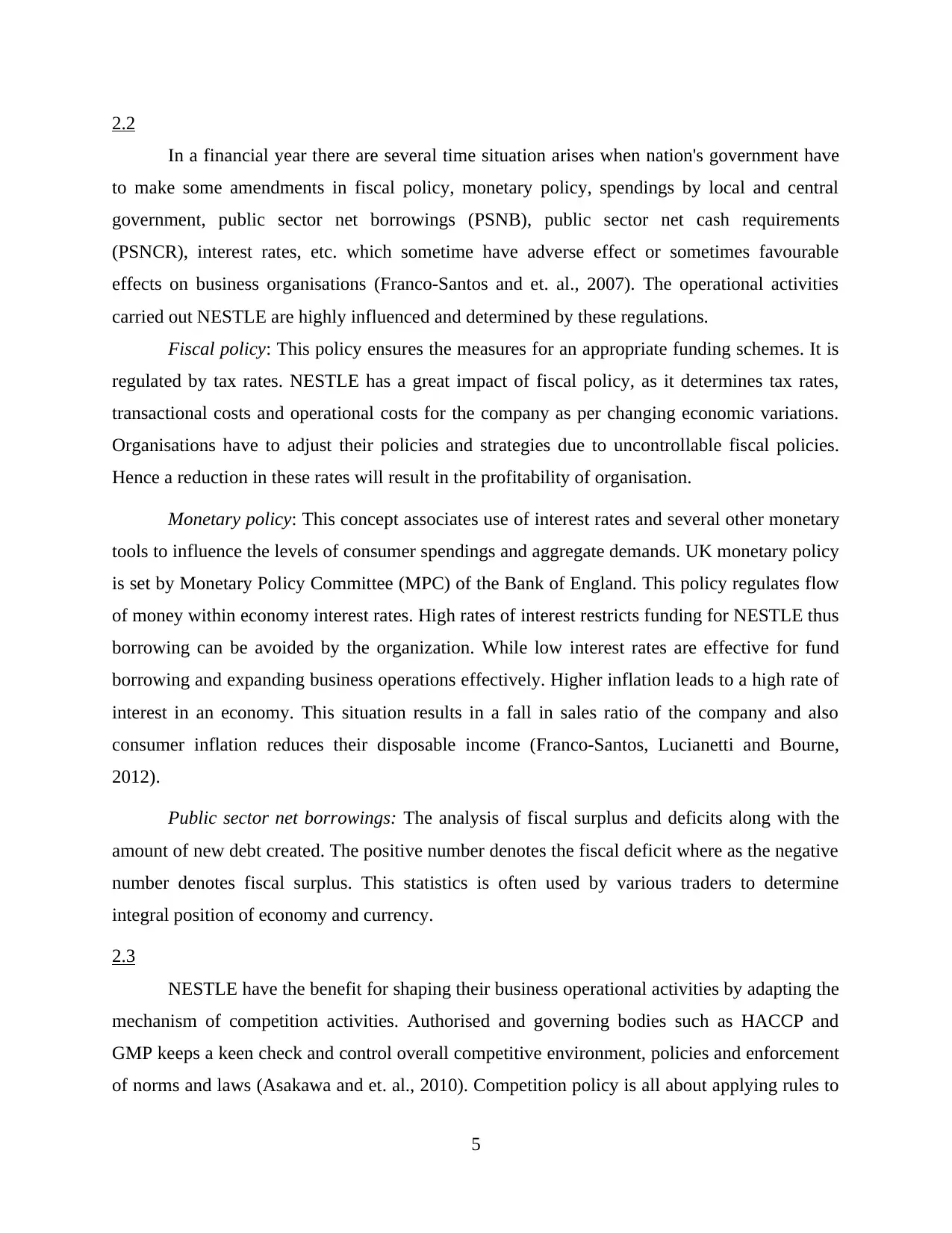
2.2
In a financial year there are several time situation arises when nation's government have
to make some amendments in fiscal policy, monetary policy, spendings by local and central
government, public sector net borrowings (PSNB), public sector net cash requirements
(PSNCR), interest rates, etc. which sometime have adverse effect or sometimes favourable
effects on business organisations (Franco-Santos and et. al., 2007). The operational activities
carried out NESTLE are highly influenced and determined by these regulations.
Fiscal policy: This policy ensures the measures for an appropriate funding schemes. It is
regulated by tax rates. NESTLE has a great impact of fiscal policy, as it determines tax rates,
transactional costs and operational costs for the company as per changing economic variations.
Organisations have to adjust their policies and strategies due to uncontrollable fiscal policies.
Hence a reduction in these rates will result in the profitability of organisation.
Monetary policy: This concept associates use of interest rates and several other monetary
tools to influence the levels of consumer spendings and aggregate demands. UK monetary policy
is set by Monetary Policy Committee (MPC) of the Bank of England. This policy regulates flow
of money within economy interest rates. High rates of interest restricts funding for NESTLE thus
borrowing can be avoided by the organization. While low interest rates are effective for fund
borrowing and expanding business operations effectively. Higher inflation leads to a high rate of
interest in an economy. This situation results in a fall in sales ratio of the company and also
consumer inflation reduces their disposable income (Franco-Santos, Lucianetti and Bourne,
2012).
Public sector net borrowings: The analysis of fiscal surplus and deficits along with the
amount of new debt created. The positive number denotes the fiscal deficit where as the negative
number denotes fiscal surplus. This statistics is often used by various traders to determine
integral position of economy and currency.
2.3
NESTLE have the benefit for shaping their business operational activities by adapting the
mechanism of competition activities. Authorised and governing bodies such as HACCP and
GMP keeps a keen check and control overall competitive environment, policies and enforcement
of norms and laws (Asakawa and et. al., 2010). Competition policy is all about applying rules to
5
In a financial year there are several time situation arises when nation's government have
to make some amendments in fiscal policy, monetary policy, spendings by local and central
government, public sector net borrowings (PSNB), public sector net cash requirements
(PSNCR), interest rates, etc. which sometime have adverse effect or sometimes favourable
effects on business organisations (Franco-Santos and et. al., 2007). The operational activities
carried out NESTLE are highly influenced and determined by these regulations.
Fiscal policy: This policy ensures the measures for an appropriate funding schemes. It is
regulated by tax rates. NESTLE has a great impact of fiscal policy, as it determines tax rates,
transactional costs and operational costs for the company as per changing economic variations.
Organisations have to adjust their policies and strategies due to uncontrollable fiscal policies.
Hence a reduction in these rates will result in the profitability of organisation.
Monetary policy: This concept associates use of interest rates and several other monetary
tools to influence the levels of consumer spendings and aggregate demands. UK monetary policy
is set by Monetary Policy Committee (MPC) of the Bank of England. This policy regulates flow
of money within economy interest rates. High rates of interest restricts funding for NESTLE thus
borrowing can be avoided by the organization. While low interest rates are effective for fund
borrowing and expanding business operations effectively. Higher inflation leads to a high rate of
interest in an economy. This situation results in a fall in sales ratio of the company and also
consumer inflation reduces their disposable income (Franco-Santos, Lucianetti and Bourne,
2012).
Public sector net borrowings: The analysis of fiscal surplus and deficits along with the
amount of new debt created. The positive number denotes the fiscal deficit where as the negative
number denotes fiscal surplus. This statistics is often used by various traders to determine
integral position of economy and currency.
2.3
NESTLE have the benefit for shaping their business operational activities by adapting the
mechanism of competition activities. Authorised and governing bodies such as HACCP and
GMP keeps a keen check and control overall competitive environment, policies and enforcement
of norms and laws (Asakawa and et. al., 2010). Competition policy is all about applying rules to
5
Paraphrase This Document
Need a fresh take? Get an instant paraphrase of this document with our AI Paraphraser
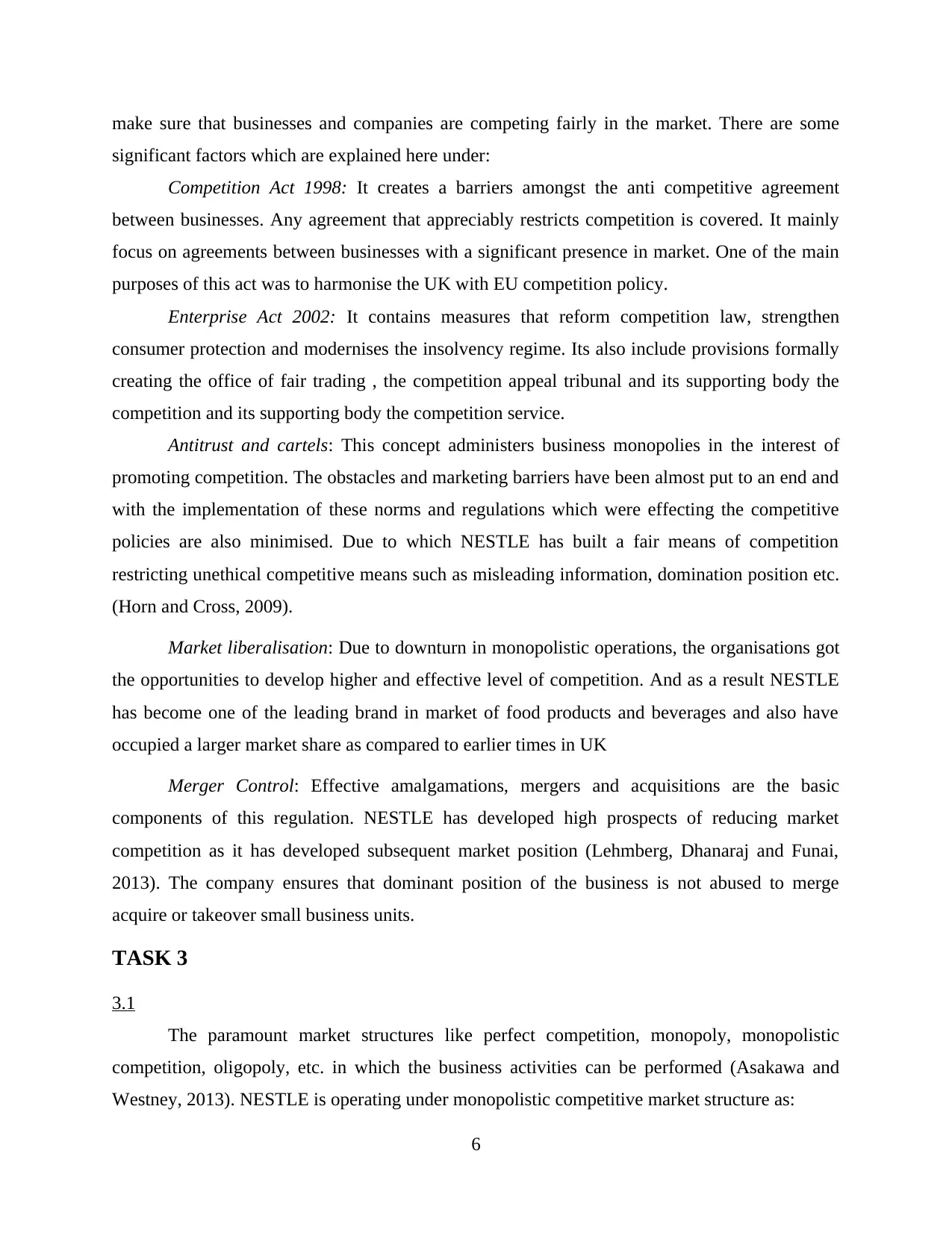
make sure that businesses and companies are competing fairly in the market. There are some
significant factors which are explained here under:
Competition Act 1998: It creates a barriers amongst the anti competitive agreement
between businesses. Any agreement that appreciably restricts competition is covered. It mainly
focus on agreements between businesses with a significant presence in market. One of the main
purposes of this act was to harmonise the UK with EU competition policy.
Enterprise Act 2002: It contains measures that reform competition law, strengthen
consumer protection and modernises the insolvency regime. Its also include provisions formally
creating the office of fair trading , the competition appeal tribunal and its supporting body the
competition and its supporting body the competition service.
Antitrust and cartels: This concept administers business monopolies in the interest of
promoting competition. The obstacles and marketing barriers have been almost put to an end and
with the implementation of these norms and regulations which were effecting the competitive
policies are also minimised. Due to which NESTLE has built a fair means of competition
restricting unethical competitive means such as misleading information, domination position etc.
(Horn and Cross, 2009).
Market liberalisation: Due to downturn in monopolistic operations, the organisations got
the opportunities to develop higher and effective level of competition. And as a result NESTLE
has become one of the leading brand in market of food products and beverages and also have
occupied a larger market share as compared to earlier times in UK
Merger Control: Effective amalgamations, mergers and acquisitions are the basic
components of this regulation. NESTLE has developed high prospects of reducing market
competition as it has developed subsequent market position (Lehmberg, Dhanaraj and Funai,
2013). The company ensures that dominant position of the business is not abused to merge
acquire or takeover small business units.
TASK 3
3.1
The paramount market structures like perfect competition, monopoly, monopolistic
competition, oligopoly, etc. in which the business activities can be performed (Asakawa and
Westney, 2013). NESTLE is operating under monopolistic competitive market structure as:
6
significant factors which are explained here under:
Competition Act 1998: It creates a barriers amongst the anti competitive agreement
between businesses. Any agreement that appreciably restricts competition is covered. It mainly
focus on agreements between businesses with a significant presence in market. One of the main
purposes of this act was to harmonise the UK with EU competition policy.
Enterprise Act 2002: It contains measures that reform competition law, strengthen
consumer protection and modernises the insolvency regime. Its also include provisions formally
creating the office of fair trading , the competition appeal tribunal and its supporting body the
competition and its supporting body the competition service.
Antitrust and cartels: This concept administers business monopolies in the interest of
promoting competition. The obstacles and marketing barriers have been almost put to an end and
with the implementation of these norms and regulations which were effecting the competitive
policies are also minimised. Due to which NESTLE has built a fair means of competition
restricting unethical competitive means such as misleading information, domination position etc.
(Horn and Cross, 2009).
Market liberalisation: Due to downturn in monopolistic operations, the organisations got
the opportunities to develop higher and effective level of competition. And as a result NESTLE
has become one of the leading brand in market of food products and beverages and also have
occupied a larger market share as compared to earlier times in UK
Merger Control: Effective amalgamations, mergers and acquisitions are the basic
components of this regulation. NESTLE has developed high prospects of reducing market
competition as it has developed subsequent market position (Lehmberg, Dhanaraj and Funai,
2013). The company ensures that dominant position of the business is not abused to merge
acquire or takeover small business units.
TASK 3
3.1
The paramount market structures like perfect competition, monopoly, monopolistic
competition, oligopoly, etc. in which the business activities can be performed (Asakawa and
Westney, 2013). NESTLE is operating under monopolistic competitive market structure as:
6
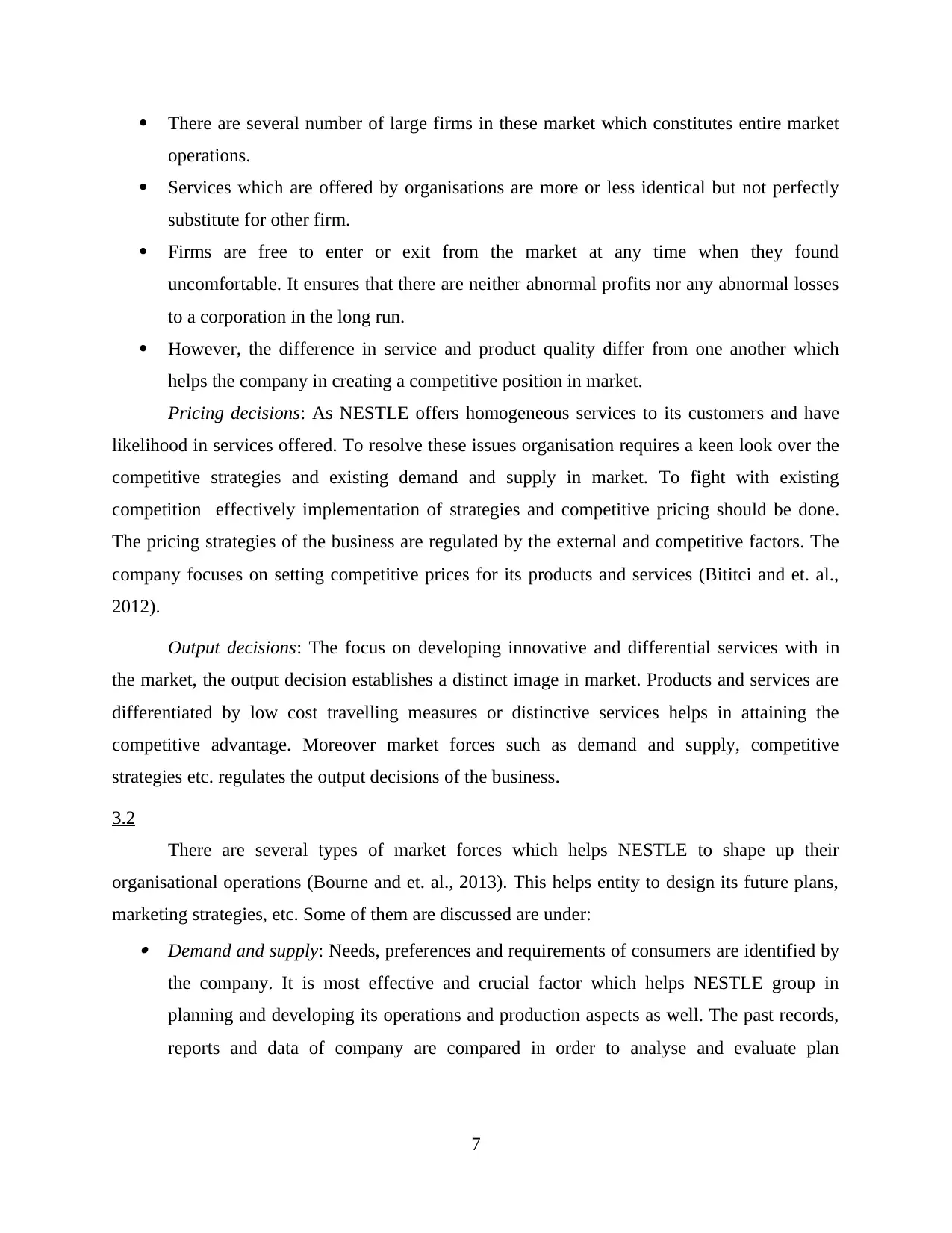
There are several number of large firms in these market which constitutes entire market
operations.
Services which are offered by organisations are more or less identical but not perfectly
substitute for other firm.
Firms are free to enter or exit from the market at any time when they found
uncomfortable. It ensures that there are neither abnormal profits nor any abnormal losses
to a corporation in the long run.
However, the difference in service and product quality differ from one another which
helps the company in creating a competitive position in market.
Pricing decisions: As NESTLE offers homogeneous services to its customers and have
likelihood in services offered. To resolve these issues organisation requires a keen look over the
competitive strategies and existing demand and supply in market. To fight with existing
competition effectively implementation of strategies and competitive pricing should be done.
The pricing strategies of the business are regulated by the external and competitive factors. The
company focuses on setting competitive prices for its products and services (Bititci and et. al.,
2012).
Output decisions: The focus on developing innovative and differential services with in
the market, the output decision establishes a distinct image in market. Products and services are
differentiated by low cost travelling measures or distinctive services helps in attaining the
competitive advantage. Moreover market forces such as demand and supply, competitive
strategies etc. regulates the output decisions of the business.
3.2
There are several types of market forces which helps NESTLE to shape up their
organisational operations (Bourne and et. al., 2013). This helps entity to design its future plans,
marketing strategies, etc. Some of them are discussed are under: Demand and supply: Needs, preferences and requirements of consumers are identified by
the company. It is most effective and crucial factor which helps NESTLE group in
planning and developing its operations and production aspects as well. The past records,
reports and data of company are compared in order to analyse and evaluate plan
7
operations.
Services which are offered by organisations are more or less identical but not perfectly
substitute for other firm.
Firms are free to enter or exit from the market at any time when they found
uncomfortable. It ensures that there are neither abnormal profits nor any abnormal losses
to a corporation in the long run.
However, the difference in service and product quality differ from one another which
helps the company in creating a competitive position in market.
Pricing decisions: As NESTLE offers homogeneous services to its customers and have
likelihood in services offered. To resolve these issues organisation requires a keen look over the
competitive strategies and existing demand and supply in market. To fight with existing
competition effectively implementation of strategies and competitive pricing should be done.
The pricing strategies of the business are regulated by the external and competitive factors. The
company focuses on setting competitive prices for its products and services (Bititci and et. al.,
2012).
Output decisions: The focus on developing innovative and differential services with in
the market, the output decision establishes a distinct image in market. Products and services are
differentiated by low cost travelling measures or distinctive services helps in attaining the
competitive advantage. Moreover market forces such as demand and supply, competitive
strategies etc. regulates the output decisions of the business.
3.2
There are several types of market forces which helps NESTLE to shape up their
organisational operations (Bourne and et. al., 2013). This helps entity to design its future plans,
marketing strategies, etc. Some of them are discussed are under: Demand and supply: Needs, preferences and requirements of consumers are identified by
the company. It is most effective and crucial factor which helps NESTLE group in
planning and developing its operations and production aspects as well. The past records,
reports and data of company are compared in order to analyse and evaluate plan
7
⊘ This is a preview!⊘
Do you want full access?
Subscribe today to unlock all pages.

Trusted by 1+ million students worldwide
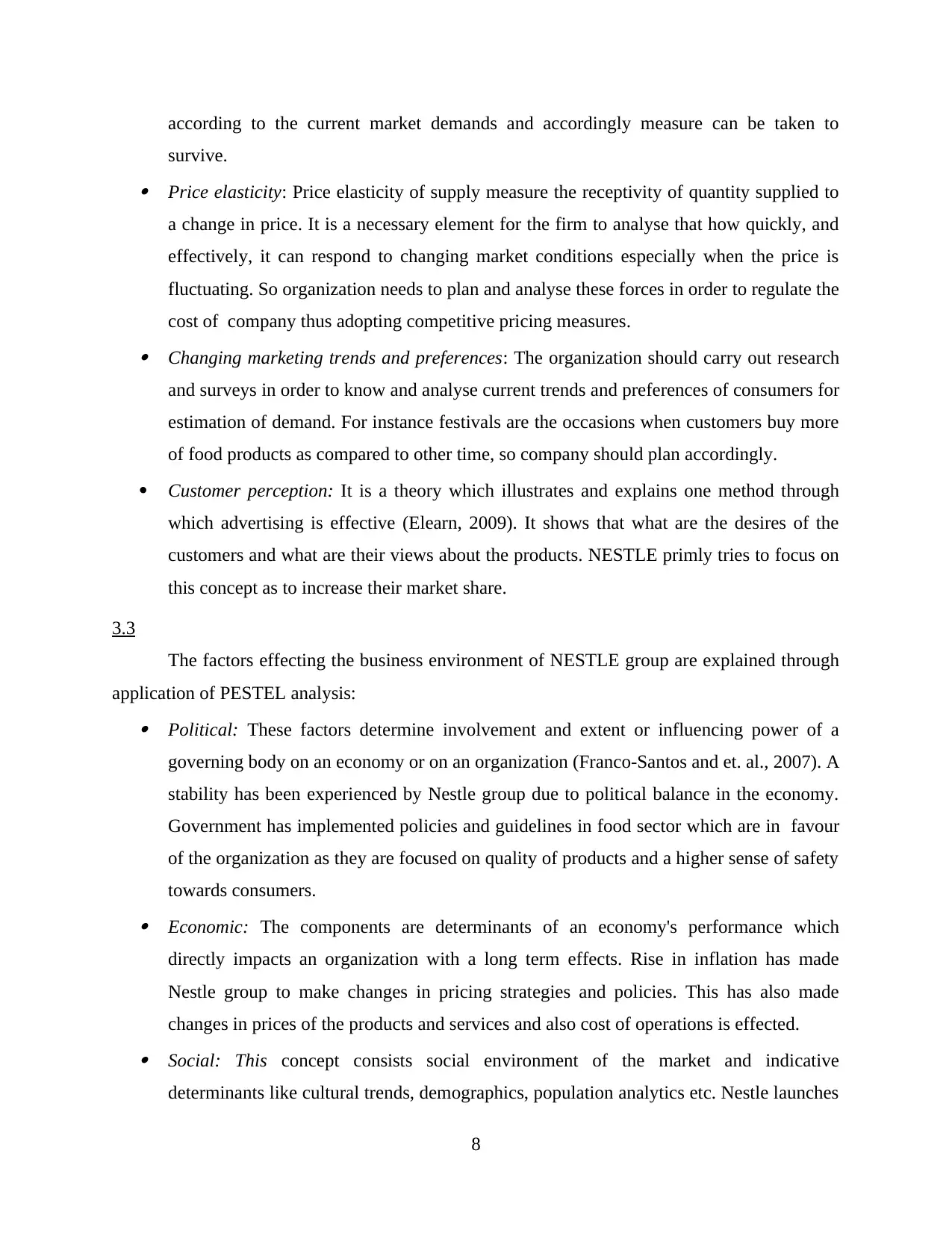
according to the current market demands and accordingly measure can be taken to
survive. Price elasticity: Price elasticity of supply measure the receptivity of quantity supplied to
a change in price. It is a necessary element for the firm to analyse that how quickly, and
effectively, it can respond to changing market conditions especially when the price is
fluctuating. So organization needs to plan and analyse these forces in order to regulate the
cost of company thus adopting competitive pricing measures. Changing marketing trends and preferences: The organization should carry out research
and surveys in order to know and analyse current trends and preferences of consumers for
estimation of demand. For instance festivals are the occasions when customers buy more
of food products as compared to other time, so company should plan accordingly.
Customer perception: It is a theory which illustrates and explains one method through
which advertising is effective (Elearn, 2009). It shows that what are the desires of the
customers and what are their views about the products. NESTLE primly tries to focus on
this concept as to increase their market share.
3.3
The factors effecting the business environment of NESTLE group are explained through
application of PESTEL analysis: Political: These factors determine involvement and extent or influencing power of a
governing body on an economy or on an organization (Franco-Santos and et. al., 2007). A
stability has been experienced by Nestle group due to political balance in the economy.
Government has implemented policies and guidelines in food sector which are in favour
of the organization as they are focused on quality of products and a higher sense of safety
towards consumers. Economic: The components are determinants of an economy's performance which
directly impacts an organization with a long term effects. Rise in inflation has made
Nestle group to make changes in pricing strategies and policies. This has also made
changes in prices of the products and services and also cost of operations is effected. Social: This concept consists social environment of the market and indicative
determinants like cultural trends, demographics, population analytics etc. Nestle launches
8
survive. Price elasticity: Price elasticity of supply measure the receptivity of quantity supplied to
a change in price. It is a necessary element for the firm to analyse that how quickly, and
effectively, it can respond to changing market conditions especially when the price is
fluctuating. So organization needs to plan and analyse these forces in order to regulate the
cost of company thus adopting competitive pricing measures. Changing marketing trends and preferences: The organization should carry out research
and surveys in order to know and analyse current trends and preferences of consumers for
estimation of demand. For instance festivals are the occasions when customers buy more
of food products as compared to other time, so company should plan accordingly.
Customer perception: It is a theory which illustrates and explains one method through
which advertising is effective (Elearn, 2009). It shows that what are the desires of the
customers and what are their views about the products. NESTLE primly tries to focus on
this concept as to increase their market share.
3.3
The factors effecting the business environment of NESTLE group are explained through
application of PESTEL analysis: Political: These factors determine involvement and extent or influencing power of a
governing body on an economy or on an organization (Franco-Santos and et. al., 2007). A
stability has been experienced by Nestle group due to political balance in the economy.
Government has implemented policies and guidelines in food sector which are in favour
of the organization as they are focused on quality of products and a higher sense of safety
towards consumers. Economic: The components are determinants of an economy's performance which
directly impacts an organization with a long term effects. Rise in inflation has made
Nestle group to make changes in pricing strategies and policies. This has also made
changes in prices of the products and services and also cost of operations is effected. Social: This concept consists social environment of the market and indicative
determinants like cultural trends, demographics, population analytics etc. Nestle launches
8
Paraphrase This Document
Need a fresh take? Get an instant paraphrase of this document with our AI Paraphraser
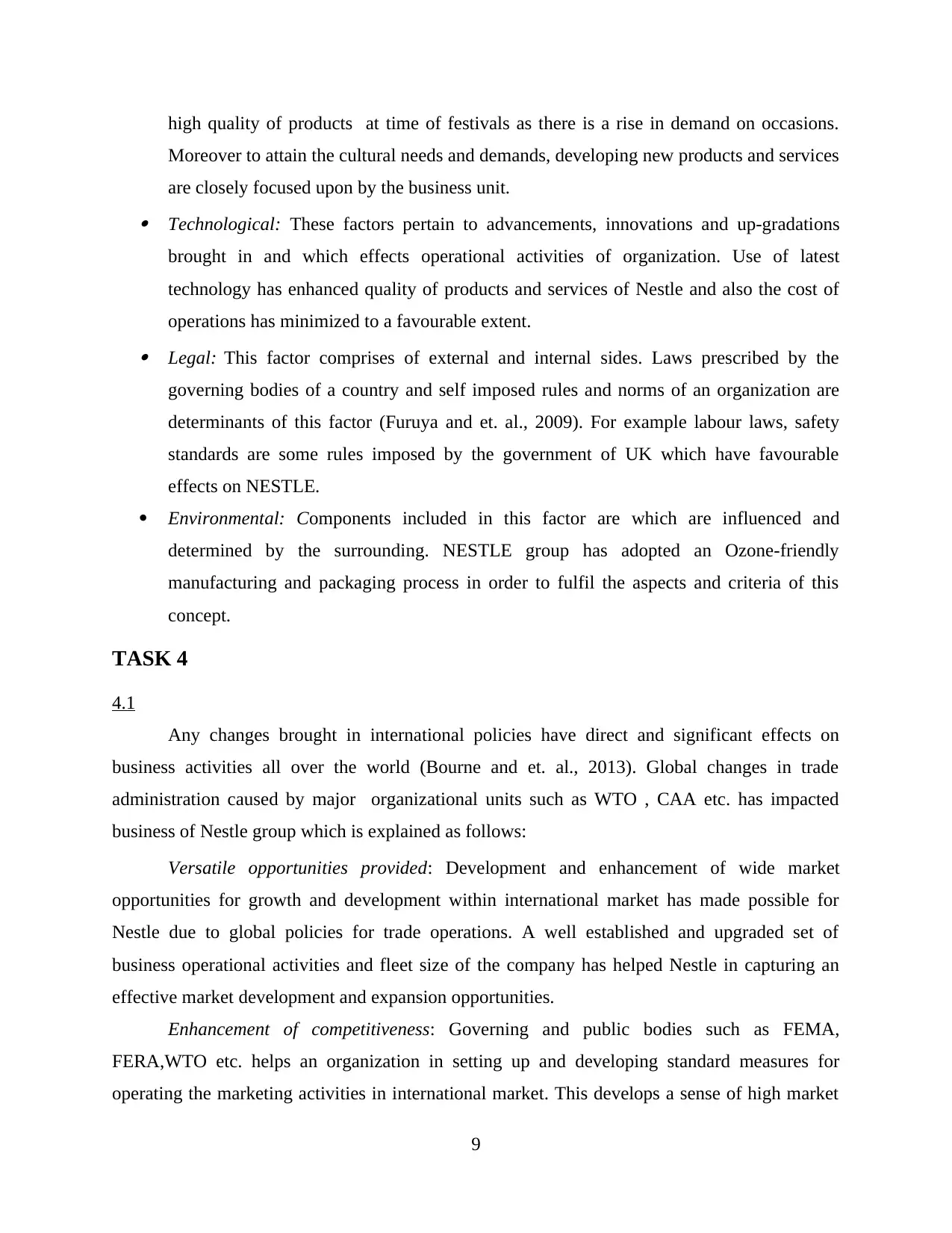
high quality of products at time of festivals as there is a rise in demand on occasions.
Moreover to attain the cultural needs and demands, developing new products and services
are closely focused upon by the business unit. Technological: These factors pertain to advancements, innovations and up-gradations
brought in and which effects operational activities of organization. Use of latest
technology has enhanced quality of products and services of Nestle and also the cost of
operations has minimized to a favourable extent. Legal: This factor comprises of external and internal sides. Laws prescribed by the
governing bodies of a country and self imposed rules and norms of an organization are
determinants of this factor (Furuya and et. al., 2009). For example labour laws, safety
standards are some rules imposed by the government of UK which have favourable
effects on NESTLE.
Environmental: Components included in this factor are which are influenced and
determined by the surrounding. NESTLE group has adopted an Ozone-friendly
manufacturing and packaging process in order to fulfil the aspects and criteria of this
concept.
TASK 4
4.1
Any changes brought in international policies have direct and significant effects on
business activities all over the world (Bourne and et. al., 2013). Global changes in trade
administration caused by major organizational units such as WTO , CAA etc. has impacted
business of Nestle group which is explained as follows:
Versatile opportunities provided: Development and enhancement of wide market
opportunities for growth and development within international market has made possible for
Nestle due to global policies for trade operations. A well established and upgraded set of
business operational activities and fleet size of the company has helped Nestle in capturing an
effective market development and expansion opportunities.
Enhancement of competitiveness: Governing and public bodies such as FEMA,
FERA,WTO etc. helps an organization in setting up and developing standard measures for
operating the marketing activities in international market. This develops a sense of high market
9
Moreover to attain the cultural needs and demands, developing new products and services
are closely focused upon by the business unit. Technological: These factors pertain to advancements, innovations and up-gradations
brought in and which effects operational activities of organization. Use of latest
technology has enhanced quality of products and services of Nestle and also the cost of
operations has minimized to a favourable extent. Legal: This factor comprises of external and internal sides. Laws prescribed by the
governing bodies of a country and self imposed rules and norms of an organization are
determinants of this factor (Furuya and et. al., 2009). For example labour laws, safety
standards are some rules imposed by the government of UK which have favourable
effects on NESTLE.
Environmental: Components included in this factor are which are influenced and
determined by the surrounding. NESTLE group has adopted an Ozone-friendly
manufacturing and packaging process in order to fulfil the aspects and criteria of this
concept.
TASK 4
4.1
Any changes brought in international policies have direct and significant effects on
business activities all over the world (Bourne and et. al., 2013). Global changes in trade
administration caused by major organizational units such as WTO , CAA etc. has impacted
business of Nestle group which is explained as follows:
Versatile opportunities provided: Development and enhancement of wide market
opportunities for growth and development within international market has made possible for
Nestle due to global policies for trade operations. A well established and upgraded set of
business operational activities and fleet size of the company has helped Nestle in capturing an
effective market development and expansion opportunities.
Enhancement of competitiveness: Governing and public bodies such as FEMA,
FERA,WTO etc. helps an organization in setting up and developing standard measures for
operating the marketing activities in international market. This develops a sense of high market
9
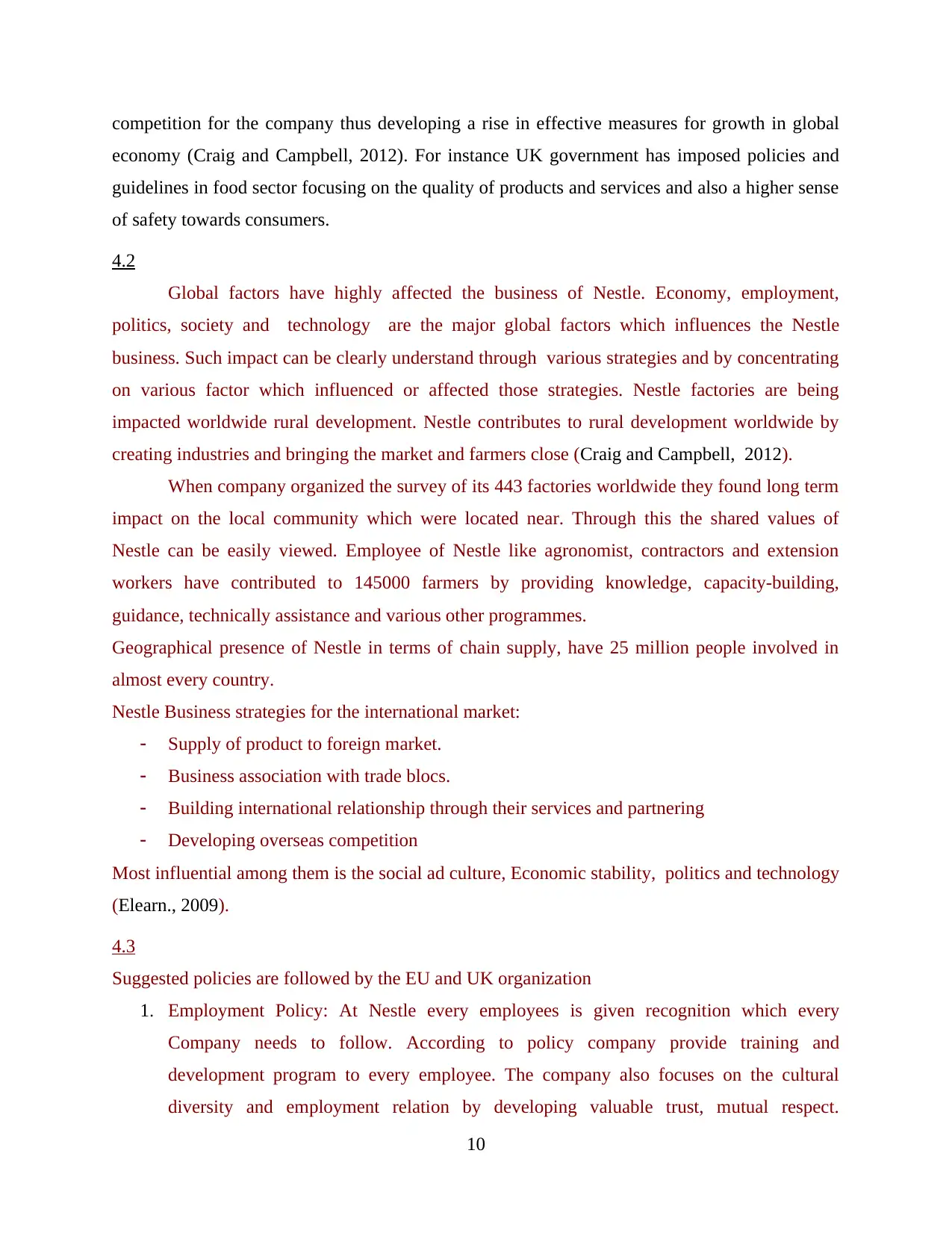
competition for the company thus developing a rise in effective measures for growth in global
economy (Craig and Campbell, 2012). For instance UK government has imposed policies and
guidelines in food sector focusing on the quality of products and services and also a higher sense
of safety towards consumers.
4.2
Global factors have highly affected the business of Nestle. Economy, employment,
politics, society and technology are the major global factors which influences the Nestle
business. Such impact can be clearly understand through various strategies and by concentrating
on various factor which influenced or affected those strategies. Nestle factories are being
impacted worldwide rural development. Nestle contributes to rural development worldwide by
creating industries and bringing the market and farmers close (Craig and Campbell, 2012).
When company organized the survey of its 443 factories worldwide they found long term
impact on the local community which were located near. Through this the shared values of
Nestle can be easily viewed. Employee of Nestle like agronomist, contractors and extension
workers have contributed to 145000 farmers by providing knowledge, capacity-building,
guidance, technically assistance and various other programmes.
Geographical presence of Nestle in terms of chain supply, have 25 million people involved in
almost every country.
Nestle Business strategies for the international market:
Supply of product to foreign market.
Business association with trade blocs.
Building international relationship through their services and partnering
Developing overseas competition
Most influential among them is the social ad culture, Economic stability, politics and technology
(Elearn., 2009).
4.3
Suggested policies are followed by the EU and UK organization
1. Employment Policy: At Nestle every employees is given recognition which every
Company needs to follow. According to policy company provide training and
development program to every employee. The company also focuses on the cultural
diversity and employment relation by developing valuable trust, mutual respect.
10
economy (Craig and Campbell, 2012). For instance UK government has imposed policies and
guidelines in food sector focusing on the quality of products and services and also a higher sense
of safety towards consumers.
4.2
Global factors have highly affected the business of Nestle. Economy, employment,
politics, society and technology are the major global factors which influences the Nestle
business. Such impact can be clearly understand through various strategies and by concentrating
on various factor which influenced or affected those strategies. Nestle factories are being
impacted worldwide rural development. Nestle contributes to rural development worldwide by
creating industries and bringing the market and farmers close (Craig and Campbell, 2012).
When company organized the survey of its 443 factories worldwide they found long term
impact on the local community which were located near. Through this the shared values of
Nestle can be easily viewed. Employee of Nestle like agronomist, contractors and extension
workers have contributed to 145000 farmers by providing knowledge, capacity-building,
guidance, technically assistance and various other programmes.
Geographical presence of Nestle in terms of chain supply, have 25 million people involved in
almost every country.
Nestle Business strategies for the international market:
Supply of product to foreign market.
Business association with trade blocs.
Building international relationship through their services and partnering
Developing overseas competition
Most influential among them is the social ad culture, Economic stability, politics and technology
(Elearn., 2009).
4.3
Suggested policies are followed by the EU and UK organization
1. Employment Policy: At Nestle every employees is given recognition which every
Company needs to follow. According to policy company provide training and
development program to every employee. The company also focuses on the cultural
diversity and employment relation by developing valuable trust, mutual respect.
10
⊘ This is a preview!⊘
Do you want full access?
Subscribe today to unlock all pages.

Trusted by 1+ million students worldwide
1 out of 15
Related Documents
Your All-in-One AI-Powered Toolkit for Academic Success.
+13062052269
info@desklib.com
Available 24*7 on WhatsApp / Email
![[object Object]](/_next/static/media/star-bottom.7253800d.svg)
Unlock your academic potential
Copyright © 2020–2025 A2Z Services. All Rights Reserved. Developed and managed by ZUCOL.





